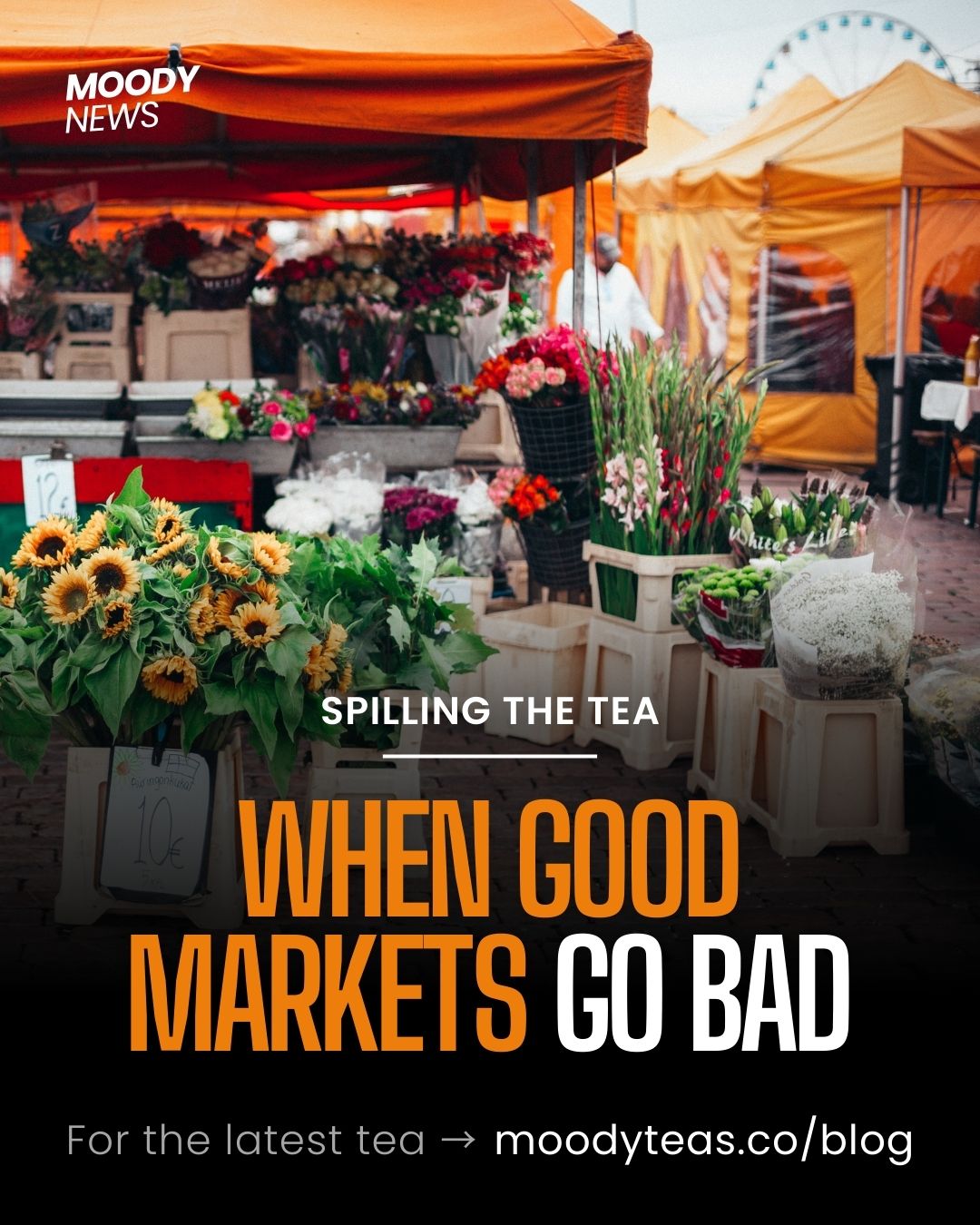Step into the world of farmers markets and craft fairs, where the excitement of fresh goodies and cool handmade stuff sometimes hides some shady business. It’s not all sunshine and rainbows in these markets—some sneaky management moves can make it really hard for the small businesses these markets claim to support. We’re about to spill the tea on the not-so-cool stuff happening behind the scenes of your favorite local markets. So, grab a seat, and let’s chat about the not-so Insta-worthy side of supporting local businesses.
Please note that we won’t be naming specific markets in this post for fear of retaliation. While many of these markets have their issues, we can’t afford to risk loosing the opportunity to vend, especially since many of them are big names in the market circle. However, if you read closely enough (or ask us in person!) we’re sure you’ll be able to put a name to several of these markets.
Over the Top Application Fees
Ever applied to a market and felt like you just paid a hefty entrance fee to a secret club instead of just a farmer’s market? Well, turns out, some markets are playing a sneaky game. They’re raking in cash with ridiculously high application fees, all the while knowing they won’t be giving most vendors a golden ticket to set up shop. These markets are basically cashing in on vendors’ dreams, and it’s time we shine a spotlight on this shady tactic. It’s a hustle that’s leaving small businesses in the dust while some markets count their stacks of application fee dollars. Talk about a not-so-welcome mat for aspiring entrepreneurs.
This practice is particularly prevalent in some of the larger, high demand farmers markets, especially the ones with more rules and requirements. That’s because it’s easy for these markets to use their laundry list of rules to turn down more vendors than they accept, while keeping their application fees. If you’ve ever wondered why we aren’t at one of Chicago’s biggest Saturday markets, this is one reason why (on principle – we haven’t applied due to some of the rules below). To make matters worse, another popular market we’ve been a part of for several years actually charged a duplicate application fee halfway through the season “accidentally” – it was later refunded, but temporarily loosing out on that cash is hard on many small businesses. So what’s the solution here? We understand the need for charging application fees, since someone has to be paid to look through them! But markets need to be upfront and transparent about their rules for eligibility, so vendors who won’t be allowed in don’t waste their money applying. And these fees need to be reasonable – there’s no reason why the application fee should cost more than 2 weeks of being at the market.
Exclusive Rules
Remember those eligibility rules we mentioned above? Some markets are laying down extensive rules, like the “must be X amount locally sourced” or “only seasonally available ingredients” commandments, that end up boxing out producers who can’t play the local game. Don’t get us wrong, we’re all for supporting locally grown, seasonal food whenever possible. But these rules ignore a whole category of vendors (like us!) who can’t access their ingredients locally. Some ingredients don’t grow locally at all – like most tea, which is rarely grown in most of North America due to climate challenges. Other ingredients can be grown locally, but aren’t available to us “little guys.” For instance, the tea that is grown in the United States is primarily owned by Bigelow and other larger tea companies. In other words, they won’t sell it to us. Similarly, while there are local herb growers, many of them don’t or can’t grow the herbs we use or the quantities we’d need. So while we use local sources whenever possible, it’s near impossible for us to be 50% or more locally sourced.
There are also vendors who require ingredients that aren’t seasonal year round – what’s a pizza without tomato sauce, but tomatoes aren’t in season all year! Requiring vendors to only use seasonally available ingredients can make it really challenging for a lot of vendors. And there’s nothing worse than bringing your product to a market only to be told you can’t sell it because it’s not in season. While these are the two most common exclusionary rules, many more exist. Requirements to be certified (which is incredibly expensive and requires lots of time and resources depending on the certification), or rules prohibiting sourcing from wholesalers or distributors also exist to exclude small vendors who don’t have the resources of larger businesses.
For many artisans, getting the best ingredients means reaching beyond their local bubble, and these markets with strict eligibility criteria are basically giving them a one-way ticket to exclusion. Let’s talk about how these rules, meant to champion local, are actually shutting out talented producers who just want a fair shot, regardless of the geographical origin of their ingredients. What’s the solution? Well, some successful markets have applied these rules primarily to farmers, which makes sense. Farms should only be selling produce they grew themselves – which means it’s inherently local and in season for them! Encouraging producers to use local ingredients whenever possible is also great, and frankly, many of us would love to collaborate with other local farms and producers whenever possible. But making these a requirement for producers excludes tons of small businesses that aren’t trying to outsource their materials, they’re just doing the best they can!
Poor Communication and Scheduling Practices
As a small business that operates out of markets and other pop up events (as opposed to a storefront), it’s crucial to know where we’re going to sell. Inconsistent scheduling, last minute changes, or loosing out on a market can devastate a small business. Navigating a market with these problems can feel like trying to follow a GPS with a mind of its own. Picture this: you’ve prepped, packed, and psyched yourself up for a successful day, only to find out the market forgot to assign you a space. On the flip side, getting a spot last minute might be great for your sales, but gives you no time to prep product. These issues are a small business nightmare, and the chaos of unpredictable schedules and lackluster communication can be devastating, leaving vendors with wasted time, spoiled goods, and a financial hit that stings. It’s time we shed light on the importance of market organizers tightening up their scheduling game, ensuring that small businesses aren’t left guessing and grasping at straws in the competitive world of market vending.
Some of the most popular markets, including one of our original farmers markets, have long wait lists of vendors due to their success, which is great! However, poor communication and scheduling have resulted in issues for both new and returning vendors. From impromptu applications opening months in advance of typical application periods, to vendors waiting 4-6 months to hear they’ve only been approved for half the dates they applied for, these issues make it hard for current vendors and near impossible for new ones. For example, we applied to one market in early November 2022 (which is about 3-4 months before most farmers market applications), nearly missing the deadline as only some vendors were notified via email. We didn’t learn until late April (a full 6 months later, with less than a month before the start of the season) that we’d only be able to attend every other week, as opposed to the full season we applied for. We understand space is limited, but letting us know the last week of April meant most other market applications had closed at least a month prior. Thankfully, we were able to pick up another market thanks to some of the other outstanding market managers, but we’ve heard from at least 3 other vendors in the same position that they weren’t able to replace these markets days. In one instance, a market manager kicked out a well known vendor of over 10 years for no discernable reason, only to reinstate them when many vendors spoke up.
For waitlisted vendors, things are even more uncertain. Many waitlisted friends of ours simply had to wait and hope they’d hear back, and we’ve heard horror stories of vendors being notified of a spot as little as 12 hours prior to the market, forcing them to come unprepared or not at all. Other waitlisted vendors have been promised a spot at some unknown future time in the season that never actually comes. And it’s important to note this doesn’t just apply to farmers markets! One of several craft fairs in Chicago just let us know they’d forgotten to include us in their planning despite being a previous vendor, so while we would have been approved for a relatively large show, we aren’t able to attend because they have run out of space. These kind of errors and miscommunications can be devastating for a small business, leaving us scrambling to find events and sales to make up the loss of revenue.
Favoritism and Unfair Enforcement
Those rules up there? Well it’s also no secret that markets often play favorites, showing love to a select few while the rest of the talented bunch get the short end of the stick. Whether it’s turning a blind eye to rule-breaking or conveniently forgetting about that “first come, first serve” policy, it’s clear that fairness sometimes takes a backseat.
This favoritism shows itself in many ways, including in rule enforcement. For instance, that popular Saturday market we mentioned with the local ingredient rules? They have a coffee vendor selling coffee not grown locally! Now we love this coffee vendor, but we can’t see how it’s fair that they can circumvent the rules that have kept so many other producers from being included.
Another example of favoritism in market management is in scheduling. One of our markets only guarantees a weekly spot to farmers, while processors like us are only allowed every other week due to high demand. However, at this same market we were placed next to a well loved producer who (absolutely no shade to them) was somehow scheduled weekly! Since we started the same season (so no seniority here), this feels incredibly unfair on the part of management, as being there weekly could be game changing for us. We understand the rule, but if it’s in place for good reason then it should be applied to everyone.
The favoritism at some markets is like being in a game where the rules change depending on who’s playing, and this market favoritism creates an uneven playing field that’s leaving some vendors feeling like they’re stuck in a popularity contest rather than a fair marketplace.
High Fees with No Return
Some markets are pulling a fast one by slapping vendors with sky-high participation fees without delivering the promised foot traffic or marketing. It’s the ultimate mismatch—vendors are left counting losses while the market organizers roll in the dough without lifting a finger to bring in customers. It’s like paying for a concert ticket only to find out the band canceled, and you’re stuck with the bill.
One prime example of this is a market we’ve been vocal about on our social media and with other local vendors – IYKYK. This brand new market opened halfway through the season, charging near double some of the most successful markets in the city. We decided to give it a shot, as we were told it was right on the River Walk, mere blocks from some of the most trafficked areas of the city. Though the price was shocking, we begrudgingly pre-purchased the 3 date package they required from all vendors. Low and behold, when we arrived we were met with a space on the driveway of an office building, at a dead end, with no customers in sight! Despite not making enough sales to even cover the fee, we tried to politely address these issues with the president of the business association (who asked for feedback), but were told we “should not come back.”
Let’s expose these fee-happy markets that leave vendors high and dry, their wallets lighter, and their faith in fair markets shaken. It’s time to call out the cash grab and demand better for the entrepreneurs trying to make an honest living.
Vendor Treatment
Last but not least, many vendors have experienced poor treatment at the hands of market staff. This can include everything from being scheduled in a space that is basically hidden from the crowd, to being threatened for speaking out about poor behavior, to markets being cancelled last minute in a power play between the city and the market. Vendors are often treated as disposable, as though the markets are doing us a favor by accepting us. While that’s true in some ways, the reality is that markets and vendors need each other. Just like vendors rely on markets to provide spaces to sell, markets need vendors in order to exist! Vendors bring so much more than just their products – we advertise the markets, we draw visitors in from our communities, and we make the market a destination! Just as we would struggle without the markets, a market without vendors won’t survive. This is why it’s so important that market management treats us with respect, because we all need each other!
So, What’s The Solution?
Listen, we don’t claim to be experts on running a market. However, we’ve been part of many, several of whom have wonderful managers who create a truly inclusive environment where both the market and the vendors thrive. How are they doing it?
- Be transparent about who you’re going to approve.
- Include all eligibility requirements up front, and if you have a lot of vendors selling the same or similar products, let new vendors know you’re not looking for more products in that category!
- Keep your application fees reasonable.
- We understand the need for fees, but recognize that this is money directly out of a vendors pocket. Sure, vendors that are approved will make that back at your market, but for vendors that don’t participate it’s a straight loss.
- Consider a case-by-case basis.
- If your market has strict eligibility rules, consider allowing exceptions on a case by case basis. For instance, markets with a “locally grown” rule might consider exceptions for vendors who can’t meet this rule for whatever reason.
- When you do make exceptions, explain! Making an exception with no explanation can look like favoritism; however, being transparent about making an exception for a vendor not only dispels rumors of favoritism, but can help other vendors who would like an exception understand what they need to do to get in.
- To use the example we cited above, we’ve heard rumors that the coffee vendor in that big Saturday market was made an exception because they sell concessions, or because they import from their family owned coffee plantation. Since the market hasn’t been transparent about this, we don’t know which is the case. If we knew the exception was made because they count as concessions, that exception could be made for us as well.
- Schedule far in advance!
- Let vendors know far in advance when they’re approved and what dates you can offer. This give vendors time to schedule other opportunities if they won’t be at your market, as opposed to leaving them out in the cold.
- Communicate early and often.
- If there are any changes in the market, whether it’s scheduling, mapping, or whatever else, let vendors know ASAP. Many market managers send a weekly update – sending this even 24 hours before is infinitely more helpful than less than 12 hours in advance, and gives both vendor and market more time to work out any resulting issues.
- Charge a reasonable fee.
- Most existing market fees are relatively reasonable, but if you’re a smaller or newer market we’d recommend looking at the pricing of existing markets of a similar size and working around that. Established and busy markets can charge more as they have the traffic and marketing to make it worth it for vendors. Newer markets with no proof of traffic shouldn’t be charging near double some of the most established markets.
- Market your market!
- Markets are only as successful as we all make them. Of course the vendors have a responsibility to market where they’ll be, but the market has a responsibility to bring in traffic too, which means marketing!
- We understand not all markets have a huge marketing budget – believe us, we know the struggle. But marketing doesn’t have to be expensive! We’re big proponents of grass roots marketing (it’s pretty much the only kind we do!) and some of our favorite markets do a great job on a limited budget. Social media and local media are two great ways to market that don’t require a large budget.
- The golden rule.
- Treat vendors the way you would want to be treated! Treating a vendor poorly with the attitude that they’re replaceable means risking loosing not just them, but other vendors as well. The vendor community in Chicago is strong, and we talk. If you are rude to a vendor, chances are many of us know about it and will take that into consideration when deciding if we want to be a part of your market.
- Remember, when the market succeeds, we all succeed.
- In the end, we all need each other to thrive. Champion the success of your vendors, and your market will thrive. We’ve seen markets double or even triple in size in just one season based on management that works towards the success of our whole community, not just their market. If you want your market to be successful, work with your vendors, not around them.
In the intricate dance between market organizers and vendors, the importance of mutual support cannot be overstated. Vendors need the markets to be on point with fair play, good communication, and a solid setup. But here’s the twist – when vendors do well, the markets shine too. It’s a win-win thing. Let’s recognize that if we want lively markets where everyone’s hustling and thriving, it’s gotta be a two-way street. By recognizing and addressing the challenges faced by vendors and market organizers alike, we can build stronger, more resilient communities where small businesses can thrive and markets can truly become the bustling, inclusive hubs they were meant to be. In this partnership, success becomes a shared journey rather than an individual pursuit.






